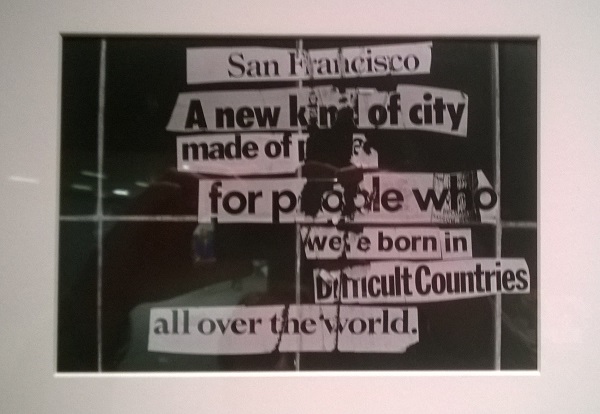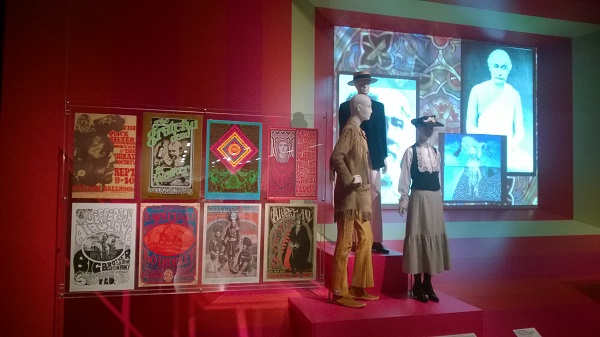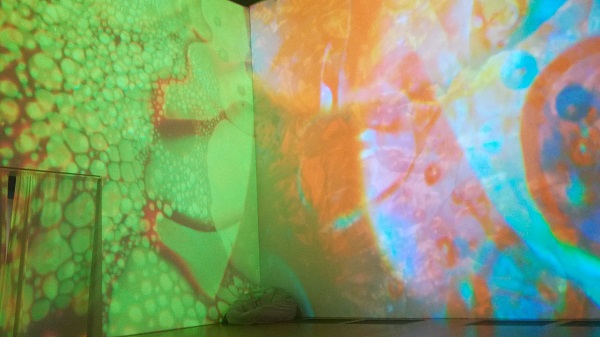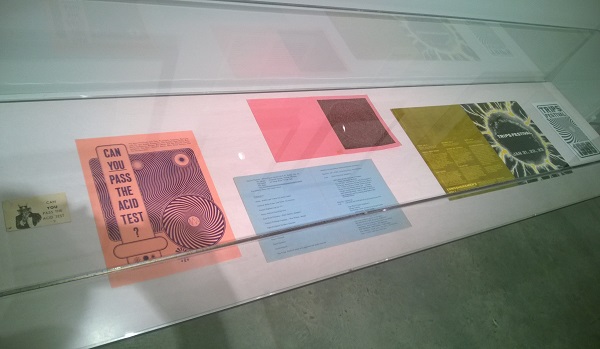Text and photos: Nikolai Sadik-Ogli 2.5.2017
 Collage by Ruth-Marion Baruch, 1967 (De Young)
Collage by Ruth-Marion Baruch, 1967 (De Young)
Like many baby-boomers, Donald Trump turned twenty-one years old while attending college in 1967, the year of the Summer of Love. At the time, Trump was studying real estate at the Wharton School of the University of Pennsylvania in a conservative business program that remained as unaffected by the countercultural radicalism of the 1960s as Trump himself (Blair, pp. 69-70; D’Antonio, pp. 187-188). The striking contrast between Trump at Wharton and the contemporary underground community of free thinkers, artists, musicians, poets, revolutionaries, magicians, psychedelic explorers, and other visionaries, travelers, and bohemians who created the Summer of Love continues to reflect a remarkable irony today: as the old hippies celebrate the fiftieth anniversary of the event, Trump, a member of their generation, has become the forty-fifth President of the United States and, like so many other things, could not care less about this celebration or the original happening. Instead, he is proposing and imposing policies that are diametrically opposed to the progressive and liberal ideals of the 1960s that were grounded in multi-culturalism, equal rights and civil rights, non-denominational spirituality, artistic self-expression, and environmentalism. Already in 1955, the Wharton School was decried as a destructive influence on science and the liberal arts (Daily Pennsylvanian, 14 January 1955, cited in D’Antonio, pp. 184-185, 937 from William Whyte, The Organization Man [Simon & Schuster, 1956], p. 93), and the same accusations have rightly been levied against the Administration of its Presidential alumnus today.
 Posters by Stanley Mouse and Alton Kelley, Randy Tuten, Victor Moscoso, Wes Wilson, and Rick Griffin (1966-1969); fashions by “Pathfinder” Frank Berry, Genie the Tailor, and Kaibab Buckskin, Inc. (1968-1970); and a still from Peace in America (1967/2017) by Ben Van Meter, Roger Hillyard, and the North American Ibis Alchemical Company (De Young)
Posters by Stanley Mouse and Alton Kelley, Randy Tuten, Victor Moscoso, Wes Wilson, and Rick Griffin (1966-1969); fashions by “Pathfinder” Frank Berry, Genie the Tailor, and Kaibab Buckskin, Inc. (1968-1970); and a still from Peace in America (1967/2017) by Ben Van Meter, Roger Hillyard, and the North American Ibis Alchemical Company (De Young)
1967: THE SUMMER OF LOVE
On 2 January 1967, Ronald Reagan started his tenure as the thirty-third Governor of California, a position that he would hold for eight years. Only a few weeks later, various underground countercultural developments in American society climaxed in an unprecedented public display for the first time at “A Gathering of the Tribes for a Human Be-In” held in San Francisco’s Golden Gate Park on 14 January 1967. The event was intended to unite the political radicals from Berkeley with the psychedelic hippies from the City’s Haight Ashbury neighborhood, and while its roots were firmly planted in the Beat Generation of the 1950s, as demonstrated by the participation of Allen Ginsberg, Lawrence Ferlinghetti, and others, it also encompassed the new psychedelic community represented by Timothy Leary, his associate Richard Alpert (later known as Ram Dass), and Stanley Owsley, the primary manufacturer of LSD in the Bay Area and manager and sound designer for the Grateful Dead, one of the many local bands that also played at the Be-In. The event was intended to unite the political radicals from Berkeley with the hippies from the City’s Haight Ashbury neighborhood and represented the juxtaposition of several trends: while the Be-In’s roots were firmly planted in the Beat Generation of the 1950s, as demonstrated by the participation of Allen Ginsberg, Lawrence Ferlinghetti, and others, its name was taken from the “Sit-In”’s of Civil Rights movement of the early 1960s, and it also encompassed the new psychedelic community represented by Timothy Leary, his associate Richard Alpert (later known as Ram Dass), and Stanley Owsley, the primary manufacturer of LSD in the Bay Area and manager and sound designer for the Grateful Dead, one of the many local bands that also played at the Be-In.
Images of the Be-In and the San Francisco scene resonated powerfully throughout America and the world. Numerous events came to be called different kinds of “-In”’s, like the television sketch comedy show “Rowan and Martin’s Laugh-In” (the pilot aired in September 1967, and the show started running regularly the following January). Having retired from live performing after a concert in Candlestick Park in San Francisco the year before, The Beatles released Sgt. Pepper’s Lonely Hearts Club Band on 1 June 1967, and, as acknowledged by a number of American hippies, the album served as the official soundtrack to the Summer of Love. Donald Trump turned twenty-one on 14 June 1967. The Monterey Pop Festival was held from 16-18 June 1967 and featured a wide array of contemporary musicians: relative unknowns like Laura Nyro, precursors of World Music like Ravi Shankar and Hugh Masekela, several bands including Big Brother and the Holding Company and The Grateful Dead who were showcased during an afternoon devoted to the groups from San Francisco, and representatives of the new psychedelic wave of the British Invasion such as The Who and The Jimi Hendrix Experience, which was fronted by an African-American with Native American ancestry who returned home as a conquering hero.
The Dead liberated some equipment from Monterey for a while to hold free concerts in Golden Gate Park, including a summer solstice celebration on 21 June 1967 where a banner on stage proclaimed the Summer of Love. The phrase originated with the Council for the Summer of Love, which had been established by a coalition of community organizations, such as the Family Dog and the Diggers, in spring 1967 to prepare for the arrival of tens of thousands of uninvited and often destitute or troubled youths into the Haight Ashbury. After the new hippies and the predators who followed them destroyed the once-idyllic scene, the end of the era was effectively signaled by the gruesome murders of a couple of drug dealers followed by “Death of Hippie, Freebie…i.e., Birth of Free American,” a ceremony staged by the Diggers on 6 October 1967 in which the participants solemnly marched through the neighborhood carrying a person posing as a corpse on a stretcher to a local park where a black coffin was burned in effigy. On 17 October 1967, Hair: The American Tribal Love-Rock Musical by James Rado and Gerome Ragni debuted Off-Broadway in New York, signaling the way in which the hippie lifestyle was co-opted and stereotyped either as a marketing tool or as a target of comedic ridicule; many of the San Francisco bands became extremely successful and moved out of the City while Hair went on to become a hit on Broadway and a major motion picture directed by Miloš Forman in 1979. In 1981, Ronald Reagan, a former movie star who was diametrically opposed to all aspects of the counterculture, was inaugurated fortieth President of the United States, and he has since become a hero to conservative Republicans, including those who voted for Trump, a former television star.
 Kinetic Light Painting (2016-2017) by Bill Ham set to music by San Francisco bands from the 1960s (De Young)
Kinetic Light Painting (2016-2017) by Bill Ham set to music by San Francisco bands from the 1960s (De Young)
2017: A YEAR OF TRUMP
Like a preemptive reaction to Trump’s potential victory, Bob Dylan was announced as the winner of the Nobel Prize for Literature in October 2016. The following month, Trump, who is a few years younger than Dylan, was elected President, the Nobel ceremony was held in December, and Trump was inaugurated on 20 January 2017. The sad irony of celebrating the leading voice of the counterculture during a time when a mouthpiece for completely opposing viewpoints achieved ultimate power is reflected in the following events and exhibitions. During the Summer of Love, Dylan lived privately in the country while recovering from a motorcycle accident sustained the preceding year and recording what came to be known as The Basement Tapes with The Band before returning to the studio in October to work on John Wesley Harding (1967). Meanwhile, Dylan’s old hero, Woody Guthrie, who had written several pieces complaining about his landlord, Trump’s father Fred, as being a racist (Kranish, pp. 163-164), died on 3 October 1967.
Reflecting the conservatism of the Trump era, 2b1 Multimedia, Inc. and Council of Light Production, who are attempting to organize a celebration in Golden Gate Park just as they beautifully did ten years ago, were denied a permit but have since applied for another one (1). Other public events have been allowed. At each of the Sunday Streets events held in different neighborhoods throughout the year, the It’s Your District organization has hosted a Summer of Love Arts and Culture Hub with commemorative exhibitions, art projects, live performances, and family-friendly activities (2) (3). Sunday Streets on 30 April 2017 took place in the Tenderloin neighborhood, which represents an interesting contrast to the Haight: as shown in the documentary Drugs in the Tenderloin (1966), the neighborhood was a destination for homosexual and drug-addicted youths shortly before the different hippie migration to the Haight, and some drug dealers operated in both neighborhoods. On Sunday, the Tenderloin Museum hosted an anti-Trump workshop that commemorated the victims of police shootings through the common household items some of them had that were mistakenly identified by officers as being guns (4). The Museum’s second anniversary celebration on 13 May will feature several presentations related to the Summer of Love, including a panel discussion about the Digger’s “Invisible Circus” that was held in the Tenderloin on 24 February 1967 (5; original posters for the Circus are included in the exhibitions at the De Young and BAMPFA discussed below). The Haight Ashbury Street Fair is scheduled for 11 June 2017, and while it is obviously recognizing the Summer of Love that started in the neighborhood, it is also celebrating its own Fortieth Anniversary as a living example of the continuing influence of the hippie era in the area (6). Other living reflections of the same spirit could be seen in the annual 4/20 marijuana celebration in Golden Gate Park on what has come to be known as Hippie Hill (for obvious reasons)(7), and the drum circle at the Earth Day Festival and Climate Rally on 22 April. One year after the idea was proposed at a UNESCO Conference in San Francisco by peace activist John McConnell, the first Earth Day celebrations were held in 1970.
Of the several museum exhibitions devoted to the Summer of Love, the primary overview is “Summer of Love: Art, Fashion, and Rock & Roll” at the De Young. It documents the many areas of fashion, music, art, journalism, literature, film, advertising, drugs, and spirituality that were explored in new ways by the local counterculture through its festivals and philosophy of adventurous, life-affirming, anti-war pacifism and pursuit of the freedoms of speech, assembly, consciousness, and lifestyle. The exhibition displays an impressive array of original flyers, films, and other ephemera from the most important events held during the preceding years that culminated in the Summer of Love. One room is devoted to the Human Be-In and features audio clips of Ginsberg and Snyder’s chanting and Leary’s explanation of the slogan, “turn on, tune in, drop out.” A forest of white mannequins inhabits almost every room showing off a wide array of fashions ranging from denim (Levi Strauss & Co. was established in San Francisco in 1853, and denim became closely associated with hippies) to macramé, crochet, and leather work done by the many tanneries that were established throughout the Bay Area the area at the time (8). The street scene, concerts, and publicity shots for several bands are also documented in the eighty-nine photographs on display in San Francisco City Hall as “Jim Marshall’s 1967” (9). Marshall’s prolific work appears in most of the other exhibitions discussed here, and the GRAMMY Museum is concurrently hosting the complementary show “Jim Marshall’s 1967 in Los Angeles” (10).
 Trips Festival program with mandala by Bruce Connor in the center, flanked on the left by Intrepid Trips, Inc. business card and Acid Test poster and on the right by Trips Festival program and handbill by Wes Wilson and Peter Bailey respectively, 1966 (BAMPFA; some of the same items were on display at the De Young)
Trips Festival program with mandala by Bruce Connor in the center, flanked on the left by Intrepid Trips, Inc. business card and Acid Test poster and on the right by Trips Festival program and handbill by Wes Wilson and Peter Bailey respectively, 1966 (BAMPFA; some of the same items were on display at the De Young)
“Hippie Modernism: The Struggle for Utopia” at the Berkley Art Museum emphasizes the countercultural involvement with science and design. One of the leading figures in this regard is Stewart Brand, who organized the Whatever It Is? Festival in 1966, was involved in the early personal computing industry in Silicon Valley, and founded the Whole Earth Catalogue. Comprehensive anticipatory design scientist Buckminster Fuller was another hippie favorite who inspired experiments such as the Drop City commune in Colorado that was founded by a group of artists in 1965. In highlighting the importance of ecology, consciousness, community, shelter, fashion, cybernetics, and journalism and advertising in relation to utopian experiments and ideals, the exhibition surveys a far wider field than just the local Summer of Love with artifacts ranging from 1963 to 1974 that include works by several European artists; for example, the light show room (also with bean bags, like the one in the De Young pictured above) features a three panel projection of Beyond Image and Son of Beyond Image (1969) by the Scottish Boyle Family (Mark Boyle and Joan Hills) set to music by Soft Machine (11). In addition to a number of special events, the adjoining Pacific Film Archive is complementing the exhibition with four programs of “Hippie Modernism Shorts” repeated daily (12) and the film series “Hippie Modernism: Cinema and Counterculture, 1964–1974” (13).
Two other exhibitions highlight the contributions of minority groups to the late 1960s scene. “Lavender-tinted Glasses: A Groovy Gay Look at the Summer of Love” at the GLBT Society Historical Archives and Museum highlights filmmaker and occultist Kenneth Anger, who lived near the Haight Ashbury from 1966 to 1967 during which time he showed his movies in local theaters, performed “The Equinox of the Gods” ceremony at the Straight Theater on 21 September 1967, and filmed the first version of Lucifer Rising (after most of the footage was stolen, the surviving remnants were used in Invocation of My Demon Brother [1969]); Janis Joplin, who was vocalist for Big Brother and the Holding Company; sexologist and astrologer Gavin Arthur, who charted the most auspicious day for the Be-In; and Allen Ginsberg. The second part of the exhibition documents the contemporary homosexual presence within the local countercultural community in general, as represented for example by a tourist map of the gay bars in the Haight (14).
“Love or Confusion: Jimi Hendrix in 1967” is a small exhibition of photographs at the Museum of the African Diaspora showing Hendrix in publicity photos from London with and without the Experience and, in shots by Jerry de Wilde that nicely complement Jim Marshall’s pictures, during the performance at Monterey where he famously set his guitar on fire with lighter fluid (15). MOAD is also hosting the “Love City Picture Show,” a film series documenting African-American and other minority activities during the 1960s, and several panel discussions about “Psychedelic Soul: Black Cultural Awakening during the Summer of Love” (16).
These exhibitions demonstrate the wide-reaching interests that the radicals and hippies of the Summer of Love had in almost all aspects of human life, grounded in humane and universal ideals of environmentalism, multi-culturalism, spirituality, and love that stand in direct contrast to the current political direction of many of the world’s governments. Just as the Trump administration promises to keep making exasperating and difficult news, some solace of resistance can be found in the many other Summer of Love exhibitions, events, and lectures that are scheduled to occur throughout the rest of the year (17).
BIBLIOGRAPHY
D’Antonio, Michael. Never Enough Donald Trump and the Pursuit of Success. New York: St. Martin’s Press, 2015.
Blair, Gwenda. Donald Trump: The Candidate. New York: Simon & Schuster, 2005.
Kranish, Michael. Trump Revealed: An American Journey of Ambition, Ego, Money, and Power. New York: Scribner, 2016.
[Note: Page numbers are cited from e-book editions viewed with the publisher’s default settings.]
LINKS
(1) http://www.50thsummeroflove.com/
(2) https://www.itsyourdistrict.org/organization/summer-of-love-street-festivals
(3) http://sundaystreetssf.com/season-schedule/
(4) http://www.tenderloinmuseum.org/public-programs/2017/4/30/this-is-not-a-gun-presented-by-100-days-of-action-tl-museum
(5) http://www.tenderloinmuseum.org/public-programs/2017/5/13/two-year-anniversary-community-free-day
(6) http://www.haightashburystreetfair.org/
(7) https://goldengatepark.com/hippie-hill.html
(8) https://deyoung.famsf.org/summer-love-art-fashion-and-rock-roll
(9) http://www.sfartscommission.org/experience-art/exhibitions/jim-marshalls-1967
(10) http://www.grammymuseum.org/exhibits/jimmarshall
(11) http://www.bampfa.berkeley.edu/program/hippie-modernism-struggle-
(12) http://www.bampfa.berkeley.edu/event/theater-2-hippie-modernism-shorts
(13) http://www.bampfa.berkeley.edu/program/hippie-modernism-cinema-and-counterculture
(14) http://www.glbthistory.org/museum/lavender-tinted-glasses/
(15) http://www.moadsf.org/exhibition/love-or-confusion-jimi-hendrix-in-1967/
(16) https://www.moadsf.org/calendar/
(17) http://summerof.love/events/
FOOTNOTE
The centennial Dada World Fair in San Francisco coincided with the election of Trump last November. Just as there were Beats and hippies who understood the importance of Dada, there was a corresponding sadness in the commemoration of that remarkable movement during this same disappointingly regressive time in human history (the author’s review of the Dada World Fair is available at https://mustekala.info/node/37783).